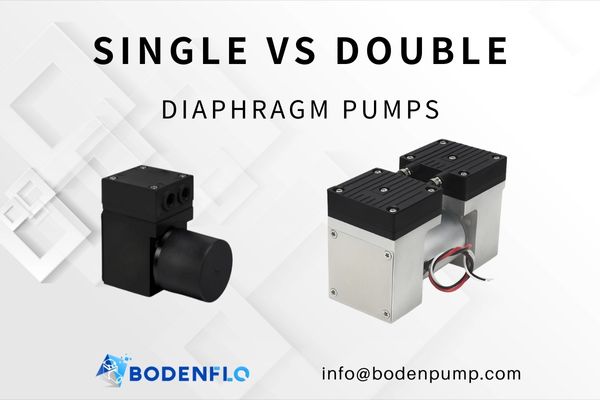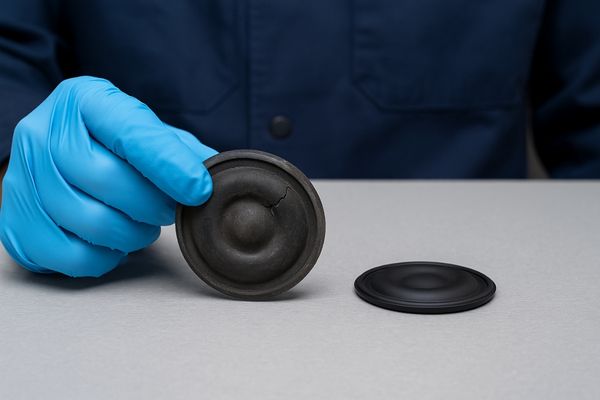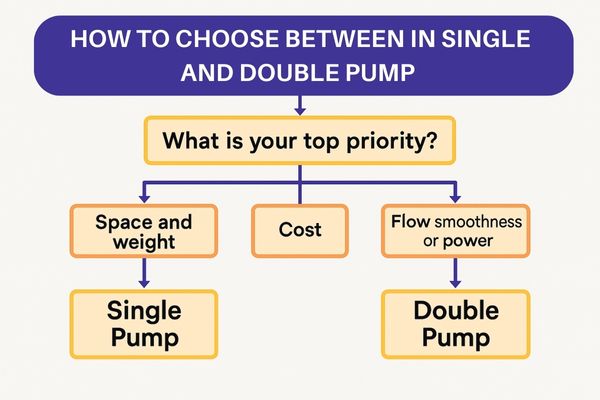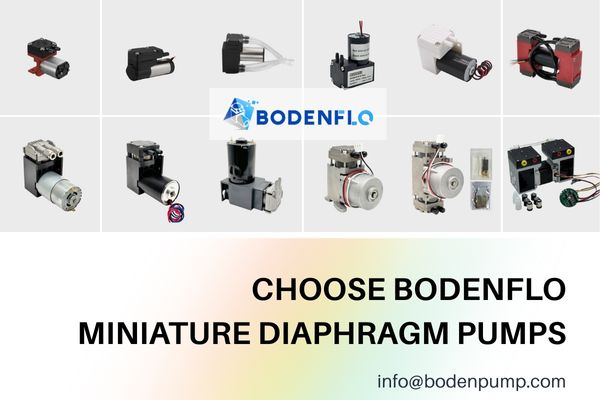Choosing the right pump configuration can be confusing. If you pick the wrong one, your device could suffer from low flow or excessive vibration, putting your entire project at risk.
The core difference is performance vs. simplicity. A single pump is compact and cost-effective for basic tasks, while a double pump uses two heads for higher, smoother flow and pressure in demanding applications.

As a project manager who has handled thousands of projects, I've seen this choice paralyze teams. It's a critical decision. To truly understand the difference, we need to go beyond the surface and compare how they work, how they perform, how they fail, and ultimately, how you choose between them. Let's break down each point of comparison so you can make the right call with confidence.
What is a single diaphragm pump?
You need a pump but want to start with the basics. Understanding the simplest form is key to seeing why a more complex version might be necessary.
A single diaphragm pump uses one flexible membrane moving up and down to create a pulsed flow of fluid. It is the most compact, lightweight, and cost-effective design, ideal for portable devices.
Think of a single diaphragm pump as the fundamental building block of this technology. Its power comes from a simple, elegant cycle that repeats rapidly to move fluid. From my experience, grasping this basic mechanism is the first step for any engineer or designer entering this space. Here’s a simple breakdown:
- The Pumping Mechanism: An electric motor is connected to an eccentric connecting rod. This rod pushes a flexible rubber diaphragm up and down inside a small, sealed chamber.
- The Two-Stroke Cycle1:
- Intake Stroke: When the diaphragm moves down, it increases the chamber volume, creating a vacuum. This suction pulls fluid in through a one-way inlet valve.
- Outlet Stroke: When the diaphragm moves up, it compresses the chamber volume, creating pressure. This pressure forces the fluid out through a one-way outlet valve.
The most defining characteristic of this pump is its pulsed flow2. Since the flow stops during the intake stroke, the output comes in small bursts. This simple and efficient design is why we can build pumps as light as 18g, making them perfect for portable gas detectors or wearable medical sensors where size is everything.
What is a double diaphragm pump?
Your application demands more performance. A standard pump isn't cutting it, and you're hitting a wall with flow, pressure, or vibration issues.
A double diaphragm pump uses two pump heads driven by a single motor. This design can be configured to double the flow rate, double the pressure, or create a much smoother, less-pulsed output.
A double diaphragm pump3 is the high-performance specialist. In many projects, we turn to this solution when a single pump just can't meet a key performance indicator. It takes the same basic principle but multiplies its power by using two heads. The magic is in how you connect them.
- Parallel Connection4 (For High Flow): In this setup, the inlets of both heads are joined, and the outlets are joined. They work together, pulling from the same source and pushing to the same destination. This doubles the total flow rate. If one head moves 15 L/min, two in parallel will deliver 30 L/min. This is critical for medical devices like respiratory therapy equipment that must supply a large volume of air to a patient.
- Series Connection (For High Pressure/Vacuum): Here, the outlet of the first pump head is connected directly to the inlet of the second. This creates a two-stage system. The second head takes the pressurized output from the first and boosts it even higher. This can double the final pressure or create a much deeper vacuum. It’s essential for lab instruments pushing fluids through high-resistance filters or for deep vacuum sampling where every bit of suction counts. Our high-performance pumps use this principle to reach up to 3.5 bar.
What is the core difference between single and dual diaphragm pumps?
You're struggling with inconsistent flow or vibration. The pulsing from a standard pump is disrupting your process or creating a poor user experience.
The biggest difference is flow smoothness and performance potential. A dual pump's heads work out of phase to cancel pulses and can be configured to double flow or pressure, unlike a single pump.
This is the most critical trade-off I discuss with project teams. The flow from a single pump stops and starts with every stroke, creating a distinct pulse. A double diaphragm pump's two heads are timed to be opposites—when one is on its intake stroke, the other is on its outlet stroke. This alternating action fills in the gaps, creating a much smoother, more continuous stream of fluid. This isn't a minor improvement; it's a game-changer for sensitive applications. The difference becomes clear when we compare them side-by-side:
| Feature | Single Diaphragm Pump | Double Diaphragm Pump5 |
|---|---|---|
| Flow Profile6 | Pulsed | Smooth, Continuous |
| Vibration | Higher | Lower |
| Max Flow/Pressure | Standard | High (up to double) |
| Size & Weight | Compact, Light | Larger, Heavier |
| Cost & Complexity | Lower | Higher |
This superior smoothness is why double diaphragm pumps are chosen for high-precision beauty applications like airbrush systems, where a consistent spray is mandatory, or for robotics, where a steady vacuum grip is essential for safe and reliable automation.
Do single and double pumps have different failure modes?
You're worried about reliability. Does a double pump mean double the trouble and twice the chance of failure in the field? This uncertainty is risky.
No, both pump types share the same primary failure modes: diaphragm wear, valve clogs, and motor burnout. Reliability is tied to component quality, not the number of heads.

This is a common concern I hear, but it's a misconception. A high-quality single pump will always outlast a poorly made double pump. Reliability is about the quality of the engineering and materials. Let's look at the common issues.
- Shared Failure Modes:
- Diaphragm Fatigue7: This is the most common wear-and-tear item. After millions of cycles, the flexible rubber diaphragm can develop a tear. This is a predictable end-of-life failure.
- Valve Debris: The small one-way valves can get stuck or fail to seal if dirt or particles get inside the pump. This is easily prevented with a simple, cheap inlet filter.
- Motor Burnout: This usually happens when a pump is used beyond its rated duty cycle8. A pump designed for intermittent use will overheat if run continuously.
- Specific Consideration for Double Pumps: A double pump has two diaphragms and two sets of valves. While this means there are more parts that will eventually wear out, it doesn't mean it's less reliable. In fact, the smoother operation can sometimes lead to less overall stress on the motor bearings and chassis. The most important factor for lifespan is always the motor type (brushless vs. brush) and material quality, which is why our pumps offer a wide lifespan range from 300 to over 10,000 hours.
How do you choose between a single and a double diaphragm pump?
You're looking at spec sheets and feeling lost. Making the wrong choice could set your project back weeks, costing time and money.
Choose by identifying your single most critical requirement. If it's cost or size, start with a single pump. If it's smoothness, high flow, or high pressure, a double pump is the necessary choice.

After guiding countless projects through this exact decision, I've developed a simple framework to cut through the confusion. It starts with one question: What is the one thing you cannot compromise on?
- Step 1: Identify Your Limiting Factor.
- Is it space and weight9? If you're building a tiny handheld or wearable device, a compact single pump is almost always the only choice.
- Is it cost10? For high-volume, cost-sensitive products, the simplicity and lower material cost of a single pump make it the default starting point.
- Is it flow smoothness? If you need vibration-free operation for sensitive sensors or a steady spray for a beauty device, you must use a double pump.
- Is it raw power? If you need flow rates approaching our maximum of 60 L/min or pressure pushing our 3.5 bar limit, a double pump configured in parallel or series is required.
- Step 2: Test a Sample in the Real World. Once you've chosen a direction based on your top priority, get a sample. A spec sheet is a promise; a real-world test in your device is proof.
- Step 3: Consult an Expert. A spec sheet doesn't tell the whole story. Talk to a supplier who understands the nuances. They can often suggest a high-torque single pump or a compact double pump that you might have overlooked.
How Does BODENFLO Help You Select the Right Pump Configuration?
You need more than just a component. You need a partner who understands your unique application and can prevent costly mistakes before they happen.
BODENFLO acts as your engineering partner. We use our deep expertise and wide product range to help you analyze trade-offs, select the optimal configuration, and validate it for your specific application.

My goal at BODENFLO isn't just to sell you a pump; it's to ensure your project succeeds. We achieve this by acting as an extension of your engineering team. This partnership approach is built on a few key pillars:
- Application-Focused Consulting: We start by listening. We want to understand your real-world challenges with performance, noise, and size for your specific medical, robotic, or automotive application.
- Expert Configuration Guidance: Based on your needs, we provide direct advice on whether a single-head or dual-head pump is the best choice. We'll help you weigh the trade-offs between a high-power single pump versus a smoother double pump.
- Access to a Wide Performance Range: Our comprehensive portfolio gives us the flexibility to find your perfect match, from tiny 18g pumps to powerful models delivering 60 L/min of air flow or 3.5 bar of pressure.
- Validation and Quality Assurance: We encourage and provide samples for you to test and validate in your actual device. Our UKAS ISO 9001:2015 certified manufacturing ensures the pump you approve is the exact same high-quality pump you receive in every production order, guaranteed.
Conclusion
Choosing between a single and a double diaphragm pump ultimately depends on what matters most to your application — whether it’s simplicity and compact size, or higher flow, smoother output, and greater pressure capability. Both configurations have their strengths, and the right choice comes from balancing performance needs with design constraints.
At BODENFLO, we are always happy to share our experience and help you evaluate the best option for your project. We don’t just deliver pumps — we aim to be a reliable partner who supports your engineering decisions with honest advice and proven solutions.
📩 If you’d like to discuss your specific requirements or test a sample, please feel free to contact us at info@bodenpump.com. We look forward to learning more about your project.
-
Exploring the Two-Stroke Cycle will enhance your knowledge of pump mechanics and efficiency. ↩
-
Understanding pulsed flow is crucial for optimizing pump performance in various applications. ↩
-
Explore this link to understand the mechanics and applications of double diaphragm pumps, crucial for high-performance tasks. ↩
-
Learn about the advantages of Parallel Connection for high flow rates, especially in critical medical applications. ↩
-
Explore the benefits of Double Diaphragm Pumps to understand why they are preferred for high-precision applications. ↩
-
Learn how Flow Profile impacts pump efficiency and application suitability, crucial for selecting the right pump. ↩
-
Understanding Diaphragm Fatigue is crucial for maintaining pump efficiency and longevity. Explore this link for expert insights. ↩
-
Understanding duty cycles is crucial for optimizing pump performance and preventing motor burnout, ensuring longevity. ↩
-
Understanding the challenges of space and weight can help you make informed design choices for your device. ↩
-
Exploring cost implications can guide you in making budget-friendly yet effective design decisions. ↩


